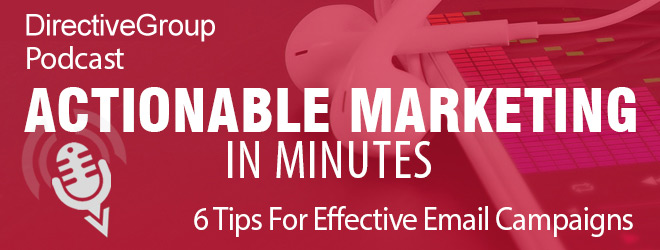In this episode of Actionable Marketing In Minutes we cover 6 tips for developing successful and effective email marketing campaigns.
Use the player below to listen to this episode, or the download link to load it on your device for listening later. You can also find our RSS feed by clicking here, or subscribe by email in the sidebar to the left.
Download our Social Media Marketing Best Practices Guide here!
Not able to listen? Why not read the episode transcript below:
Problem
Here’s a question. Is it your habit to check your email first thing in the morning? If so, you are one of the 58% of adult Americans who do, says Jay Baer, author of Youtility. That fact speaks to the importance of developing good email marketing campaigns as part of your marketing programs.
Email marketing campaigns can build relationships, enable you to gather important information and help boost your marketing effectiveness. But, to build, execute and maintain an effective campaign, you must be mindful of your audience, your message and your consistency. To ensure success, it is crucial that you don’t just ‘batch & blast’ self-promotional emails, but that your emails offer some real value, as perceived by your audience.
If implemented correctly, email marketing campaigns can be a cost-effective way to get the mindshare of your existing subscribers, learn about their interests, and gain new subscribers – all of which will result in new business for you.
Solution
If you’re ready to get serious about starting a new campaign, or making your current lackluster campaign more robust, consider the following 6 guidelines.
1. Always include social share buttons: this encourages your audience to continue the conversation on social channels, and thinking from the user perspective, often being the first to share something really cool is just how your great emails get widely distributed.
2. Measure engagement: although top level metrics are important, go a step further and explore all info available, such as where click-through visitors went on you website, number and frequency of visits, and social sharing. Knowing their behavior will lead to the ability to develop and test segmentation strategies.
3. Create more complex segmentation: once you have enough information, act! Subset your standard segmentation variables based on behavioral data. Then continue to look at all the visitors’ behavior while on your site. This will give you ideas on how you might customize offers to better fit their needs.
4. Hone in: Tailor your relevant, value-added message to the various segments generated by following the previous two ideas. In addition to sending different email messages to different segments, consider testing different offers or different solutions as well.
5. Avoid spam triggers: double check your email to make sure you’ve not inadvertently including any common spam trigger words. Google ‘spam trigger words’ to find hundreds of such words.
6. Test, test & test again: the smallest detail can make a world of difference. Use A/B tests to test two versions of your emails to see which is more successful. Some of the elements you might test are: headlines, images,
structure of content, length of content, use of multi-media, different offers, and more. Soon you will learn what your customer segments respond best to, and you can continue the process of refinements for ever-increasing success. We call that a virtuous cycle.
Benefits
Once you’ve set up a solid email program, you are sure to notice the following benefits.
* An increase in an engaged audience.
* Increased social shares and email forwards.
* An increase in your website visitors who click through links from your email.
* Increased conversion rates.
We hope you’ve found this information helpful. Please connect with us on Twitter @DirectiveGroup or on LinkedIn. Let us know what you think and what you’d like to hear about next. And if you like our podcasts, please share with your networks using hashtag #actionablemarketing. Join us next time for more actionable marketing in minutes.
Podcast: Play in new window | Download (Duration: 5:29 — 3.9MB) | Embed
